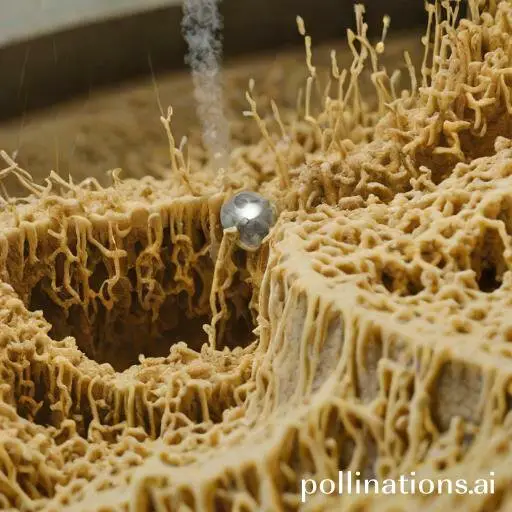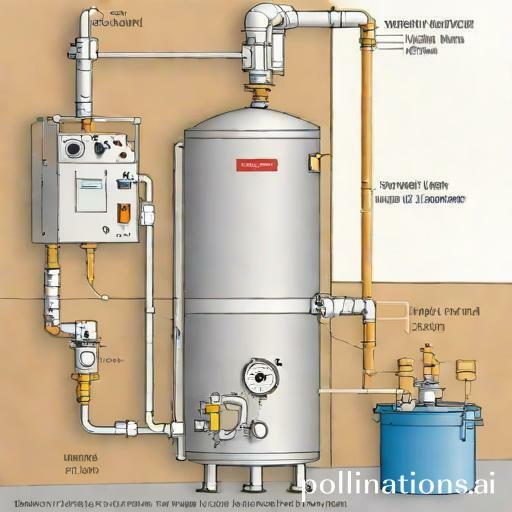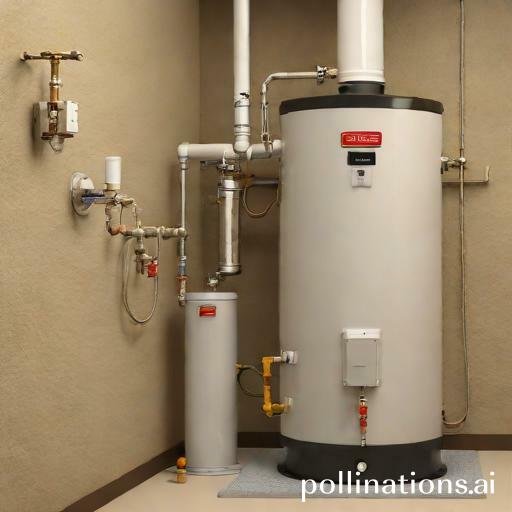
Sediment accumulation in water heaters is a common issue that many homeowners face. Over time, minerals and debris from the water supply can settle at the bottom of the tank, causing problems such as reduced efficiency and potential damage to the heating element.
This buildup can also lead to decreased hot water supply and increased energy consumption. Apprehending the reasons behind sediment accumulation can help homeowners take preventive measures and ensure the longevity and optimal performance of their water heaters.
Causes of Sediment Accumulation in Water Heaters
Sediment accumulation in water heaters can lead to various issues, such as reduced efficiency, increased energy consumption, and potential damage to the heater itself. Comprehending the causes of sediment buildup can help homeowners prevent these problems and ensure the longevity of their water heaters.
1. Hard Water
Hard water, which contains high levels of minerals like calcium and magnesium, is a common cause of sediment accumulation in water heaters. As the water is heated, these minerals can precipitate and settle at the bottom of the tank, forming a layer of sediment over time. This sediment can impair the heater’s performance and reduce its efficiency.
One effective solution to combat hard water is to install a water softener system. This system removes the excess minerals from the water, preventing their accumulation in the heater and other plumbing fixtures throughout the house.
2. High Water Pressure
High water pressure can also contribute to sediment buildup in water heaters. When water flows into the tank at a high pressure, it stirs up any existing sediment and allows it to settle more easily. This can result in a thicker layer of sediment forming over time.
To mitigate this issue, homeowners can consider installing a pressure-reducing valve (PRV) to regulate the water pressure entering the water heater. This will help minimize the disturbance of sediment and reduce the likelihood of accumulation.
3. Lack of Maintenance
A lack of regular maintenance can significantly contribute to sediment accumulation in water heaters. Without periodic flushing or cleaning, sediment can build up and harden, making it more challenging to remove and increasing the risk of damage to the heater.
It is recommended to schedule annual maintenance for water heaters, including draining and flushing to remove any accumulated sediment. This simple maintenance task can help prevent performance issues and extend the lifespan of the heater.
4. Age of the Water Heater
The age of the water heater can also play a role in sediment accumulation. Over time, as the heater operates, sediment can gradually build up, especially if proper maintenance has not been performed.
When a water heater reaches a certain age, typically 8-12 years, it may be more prone to sediment accumulation. In such cases, it might be more cost-effective to replace the water heater rather than attempting to remove the accumulated sediment.
| Causes | Effects |
|---|---|
| Hard water | Reduced efficiency, increased energy consumption |
| High water pressure | Thicker sediment buildup, potential damage to the heater |
| Lack of maintenance | Hardened sediment, decreased performance |
| Age of the water heater | Increased risk of sediment accumulation |
Effects of sediment buildup in water heaters
Water heaters play a crucial role in our daily lives, providing us with hot water for various purposes. Conversely, sediment buildup in water heaters can have several negative effects that can impact their efficiency and lifespan.
1. Reduced efficiency
When sediment accumulates at the bottom of a water heater, it creates a layer that acts as an insulator. This insulating layer prevents the heat from transferring efficiently to the water, resulting in reduced efficiency. As a result, it takes longer for the water to heat up, leading to increased energy consumption.
2. Increased energy bills
Due to the reduced efficiency caused by sediment buildup, water heaters need to work harder and consume more energy to heat the water to the desired temperature. This increased energy consumption reflects in higher energy bills, putting a strain on your finances.
3. Shortened lifespan of the water heater
Sediment buildup not only affects the immediate efficiency of a water heater but also contributes to its long-term durability. The accumulation of sediment can cause corrosion and damage to the internal components of the heater, leading to a shortened lifespan. Regular maintenance and flushing of the tank can help mitigate this issue.
4. Risk of leaks and burst tanks
As sediment settles at the bottom of the tank, it can create an uneven distribution of heat, causing certain areas to overheat. This overheating can weaken the tank’s structure, increasing the risk of leaks and even burst tanks. Regular flushing and maintenance can help prevent such catastrophic failures.
Prevention of Sediment Accumulation in Water Heaters
Water heaters are an essential appliance in every household, providing hot water for various daily activities. Nevertheless, over time, sediment can accumulate in the tank, affecting the efficiency and lifespan of the water heater. To ensure optimal performance and prolong the life of your water heater, here are some preventive measures:
1. Flushing the Tank Regularly
Regularly flushing your water heater tank is crucial in preventing sediment buildup. Sediment, such as minerals and debris, can settle at the bottom of the tank, causing corrosion and reducing heating efficiency. By flushing the tank, you can remove these sediments and maintain the heater’s performance. It is recommended to flush the tank at least once a year.
2. Installing a Water Softener
Hard water contains high levels of minerals, such as calcium and magnesium, which contribute to sediment accumulation. Installing a water softener can help reduce the mineral content in the water, thereby minimizing sediment buildup in the water heater. A water softener replaces these minerals with sodium ions, preventing scale formation and sediment deposition.
3. Reducing Water Pressure
High water pressure can cause turbulence inside the water heater tank, leading to increased sediment settlement. By reducing the water pressure to a recommended level, you can minimize the disturbance and sediment accumulation. Consult a professional plumber to adjust the water pressure to an optimal level suitable for your water heater.
4. Using a Sediment Filter
Installing a sediment filter in the water supply line can effectively trap and remove sediment particles before they enter the water heater. This filter acts as a barrier, preventing sediments from reaching the tank and causing buildup. Regularly cleaning or replacing the sediment filter will ensure its efficiency and maintain a sediment-free water heater.

Maintenance of Water Heaters to Prevent Sediment Buildup
Water heaters play a crucial role in providing hot water for various household activities. To ensure their optimal performance and longevity, it is essential to regularly maintain them and prevent sediment buildup. This article focuses on the key steps involved in maintaining water heaters and keeping them free from sediment.
1. Checking the Anode Rod
The anode rod is a critical component of a water heater that helps prevent corrosion. Over time, it can degrade due to the chemical reactions occurring inside the tank. Regularly checking and replacing the anode rod is essential to prevent sediment formation and extend the lifespan of the water heater.
2. Inspecting the Heating Element
The heating element is responsible for heating the water in the tank. Sediment buildup can affect its efficiency and lead to higher energy consumption. Regularly inspecting the heating element and cleaning it if necessary can help maintain its performance and prevent sediment accumulation.
3. Monitoring the Thermostat
The thermostat controls the temperature of the water in the tank. Sediment buildup can affect its accuracy, leading to inconsistent water temperatures. Regularly monitoring and adjusting the thermostat can help prevent sediment accumulation and ensure the water heater operates at the desired temperature.
4. Cleaning the Tank and Pipes
Sediment can accumulate inside the tank and pipes, reducing the water heater’s efficiency and potentially causing damage. Regularly cleaning the tank and pipes by flushing them with water can help remove sediment and prevent clogs. It is essential to follow the manufacturer’s instructions or seek professional assistance for thorough cleaning.
| Step | Description |
|---|---|
| 1 | Checking the Anode Rod |
| 2 | Inspecting the Heating Element |
| 3 | Monitoring the Thermostat |
| 4 | Cleaning the Tank and Pipes |

Removal of Sediment from Water Heaters
Regular maintenance of water heaters is essential to ensure their optimal performance and longevity. One crucial aspect of maintenance is the removal of sediment that accumulates over time. Sediment buildup can lead to reduced efficiency, decreased water pressure, and even potential damage to the heating elements. Here, we outline several methods for effectively removing sediment from water heaters:
1. Draining the Tank
The first step in sediment removal is draining the tank. Start by turning off the power supply to the water heater. Attach a hose to the drain valve and place the other end in a suitable drainage area or bucket. Open the drain valve and allow the water to flow out until it appears clear. This process helps flush out loose sediment that has settled at the bottom of the tank.
2. Flushing the Tank with Vinegar
Vinegar is a natural and effective cleaning agent that can help remove stubborn sediment deposits. After draining the tank, close the drain valve and pour a mixture of vinegar and water into the tank. The recommended ratio is one part vinegar to three parts water. Let the solution sit in the tank for a few hours to dissolve the sediment. Then, drain the tank once again to remove the loosened deposits.
3. Using a Descaling Agent
If the sediment buildup is severe, using a descaling agent can provide a more thorough cleaning. These agents are specifically designed to dissolve mineral deposits and scale. Follow the instructions provided by the manufacturer to safely and effectively use the descaling agent. After the recommended duration, flush the tank with water to remove any residue.
4. Hiring a Professional Plumber
If you are unsure about performing sediment removal yourself or if the sediment buildup is extensive, it is advisable to hire a professional plumber. Experienced plumbers have the necessary tools and expertise to thoroughly clean the water heater and ensure its optimal functioning. They can also inspect other components and address any potential issues.
| Method | Effectiveness | Complexity |
|---|---|---|
| Draining the Tank | Medium | Low |
| Flushing with Vinegar | High | Low |
| Using a Descaling Agent | High | Medium |
| Hiring a Professional Plumber | High | High |
Bottom Line
Sediment accumulation in water heaters is a common problem that can lead to reduced efficiency, increased energy costs, and even damage to the tank. The accumulation of minerals and other debris in the tank can also affect the quality of the water and lead to health concerns. Regular maintenance and flushing of the tank can help prevent sediment buildup and extend the life of the water heater. Fundamental to follow manufacturer guidelines and seek professional help if necessary. Additionally, using a water softener or filtration system can help reduce the amount of minerals and debris entering the tank. By taking proactive steps to prevent sediment accumulation, homeowners can ensure their water heater operates efficiently and provides safe, clean water for their household needs.
Read More:
1. How Often Should I Flush My Water Heater To Remove Sediment?
2. Are There Preventive Measures To Avoid Sediment Buildup?










